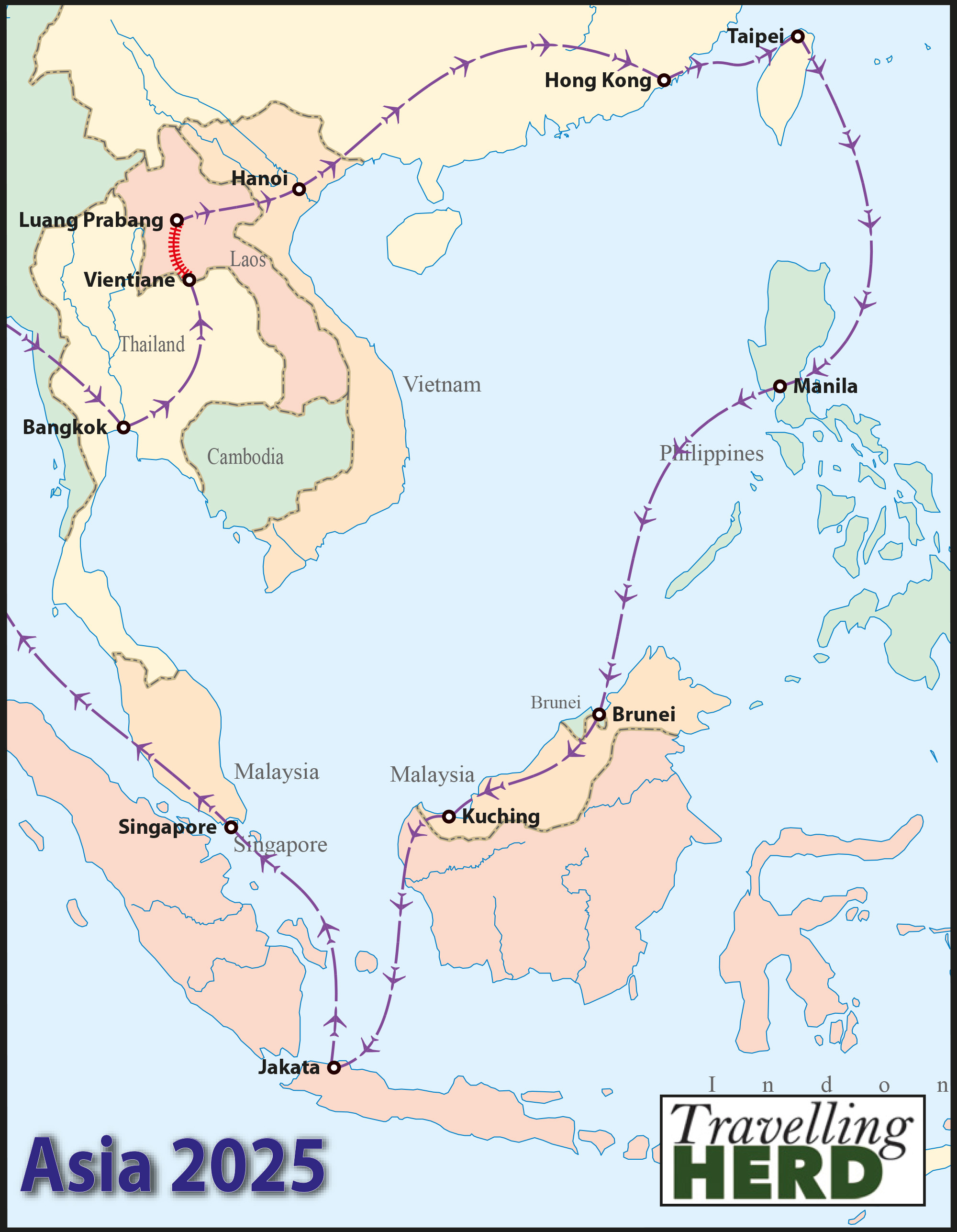Read this blog: The one where Matilda gets to have her cake and eat it [twice]
Friday 14th and Saturday 15th February 2025
Our flight to Wattay International Airport in Vientiane left from Don Mueang International Airport in Bangkok and we booked a taxi from the hotel to take us there. To our surprise, the driver seemed to be trying to tell us that it was expensive in Laos.
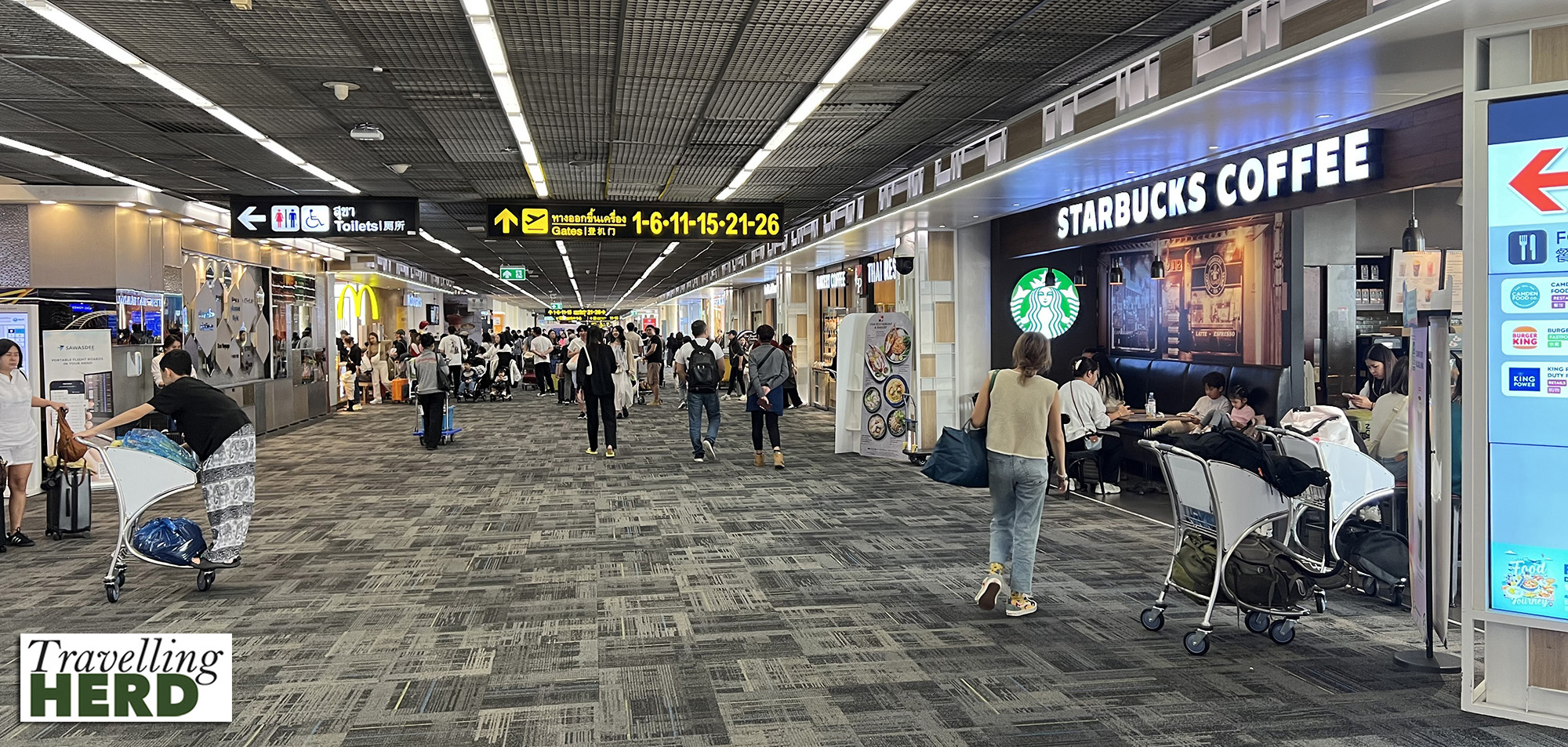
As we stood in the queue to board, the man waiting behind us first complimented Robert on his Hawaiian shirt. This happens a lot. As the conversation progressed it transpired that he was an American athletics coach specialising in the pole-vault currently travelling on a year’s sabbatical. One of his students was a teenage girl from London.
When Robert told him that he was also a pole-vaulter, the coach looked at his current girth and said good-naturedly, “a little while ago”. Some readers will be surprised to find out that Robert was an English schools level pole-vaulter and still in fact holds his school record for pole-vaulting, which he set over 40 years ago. He represented not only Warwickshire AAA but also the West Midland Schools at the English Schools Athletics competitions.
We were sat behind the coach on the plane and the conversation expanded to encompass various types of pole, the sort of craziness needed to succeed in pole-vaulting and developments in the sport over the years. Robert’s new-found friend had in his own time held the Cambodian pole-vaulting record, and did say that none of his students could yet beat him.
We flew AirAsia which is a budget/no frills airline. As Robert had a suitcase which would not have complied with the dimensions allowed as hand luggage he had booked a package of add-ons which included checking in our cases to go in the hold, choosing our seats and an in-flight meal. Not many people had chosen to pay the extra.
As the cabin crew came through offering people the chance to buy food and drinks, they also handed some people immigration forms, but it seemed they did not feel we needed one.
We did.
Although we had printed copies of the e-visas which Robert had bought for us in advance we still needed to complete an immigration form. It would have been easier to do this in advance on the plane, as there were only a few tables to lean on in the immigration hall itself and even fewer pens. Fortunately Matilda had her trusty pencil case in her hand luggage. So our advice would be to get an e-visa in advance and make sure you take your own pens and that the cabin crew give you an immigration form to complete in-flight.
The queue through immigration for those with an e-visa was much shorter than any of the others lanes.
It was only after he had taken a photo of the welcome sign that Robert realised it was an advert for the local beer.
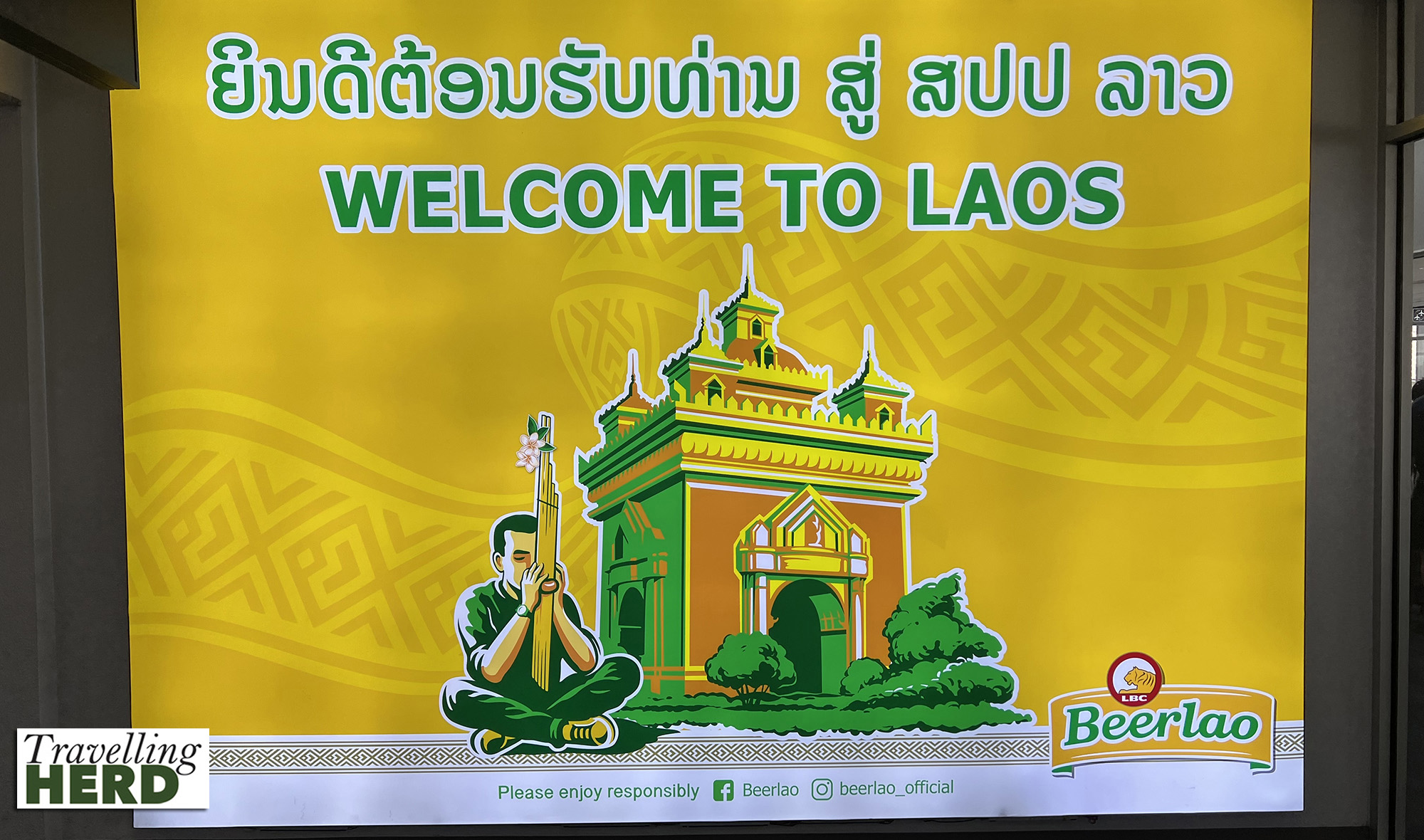
The Kip currency has no value outside Laos and therefore it is not readily traded. We had brought crisp new US dollars to exchange for Kip at the airport.
An official taxi service operates here. You tell them your destination and are quoted a price. Although an announcement on the plane stated that it was illegal to pay in anything other than Kip in Laos we discovered that you can actually pay for your taxi in either US dollars or Kip. We handed over dollars which the cashier exchanged for Kip to give the driver. Having been paid his fare, he gestured for us to follow him outside and then wait while he went to get his vehicle. We did briefly wonder whether he might be making off with the cash but he returned quite promptly.
As we checked into our hotel, we were informed that the pool would be closed from 16:00 for a private Valentine’s Day party so we visited the pool area briefly to see what it was like before it closed.
Having checked into our hotel and checked out the pool we decided to go and get our bearings. A short walk took us to the banks of the Mekong River. We had envisaged a bustling river bank with bars and cafés but it looked as though a new meander was being created and the water was further away than we expected. The Mekong River forms the border between Laos and Thailand and so Thailand is visible in the distance.
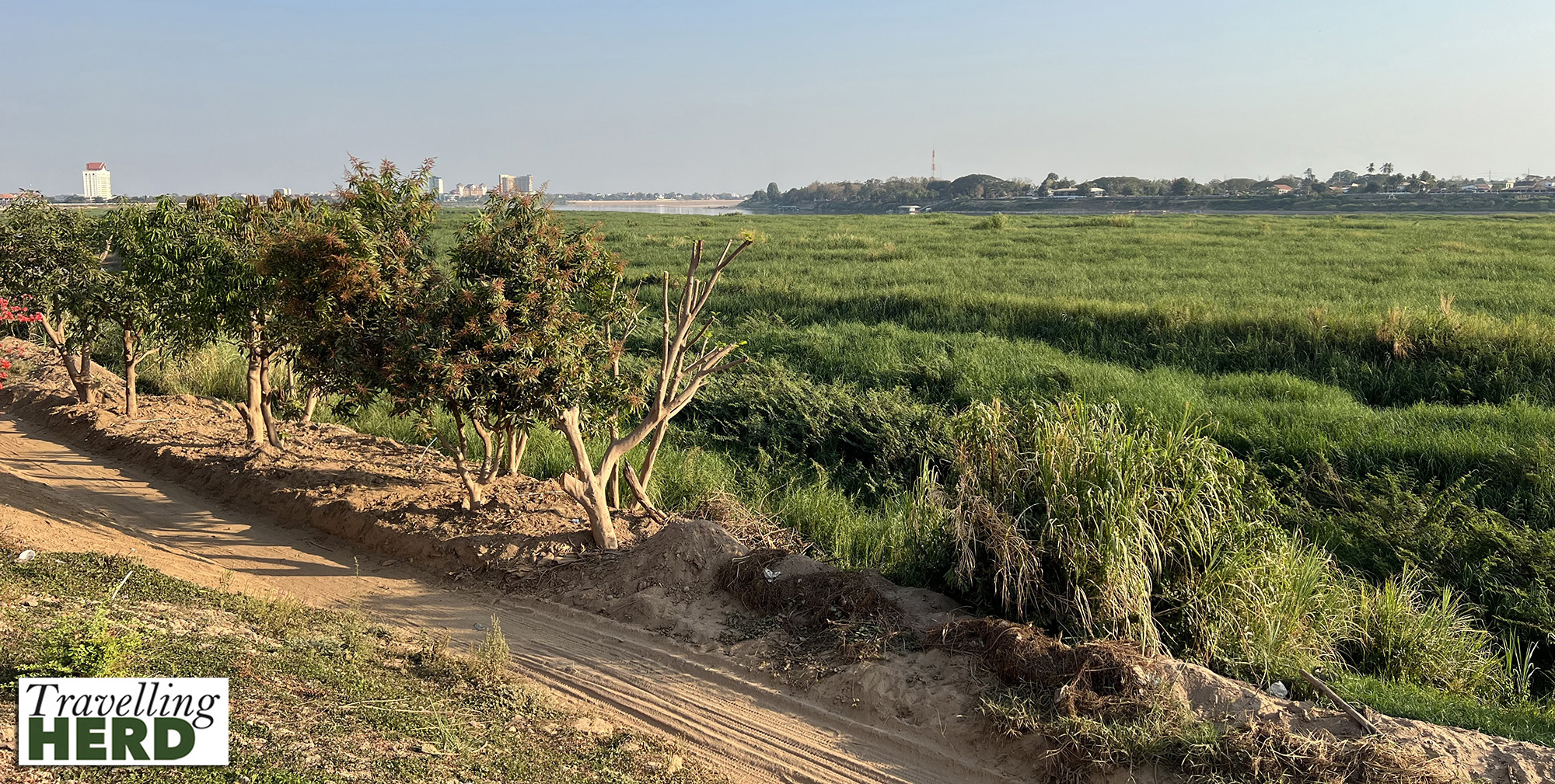
We had our first taste of Beerlao upstairs in the dappled shade at Samyek Pakpasack Restaurant.
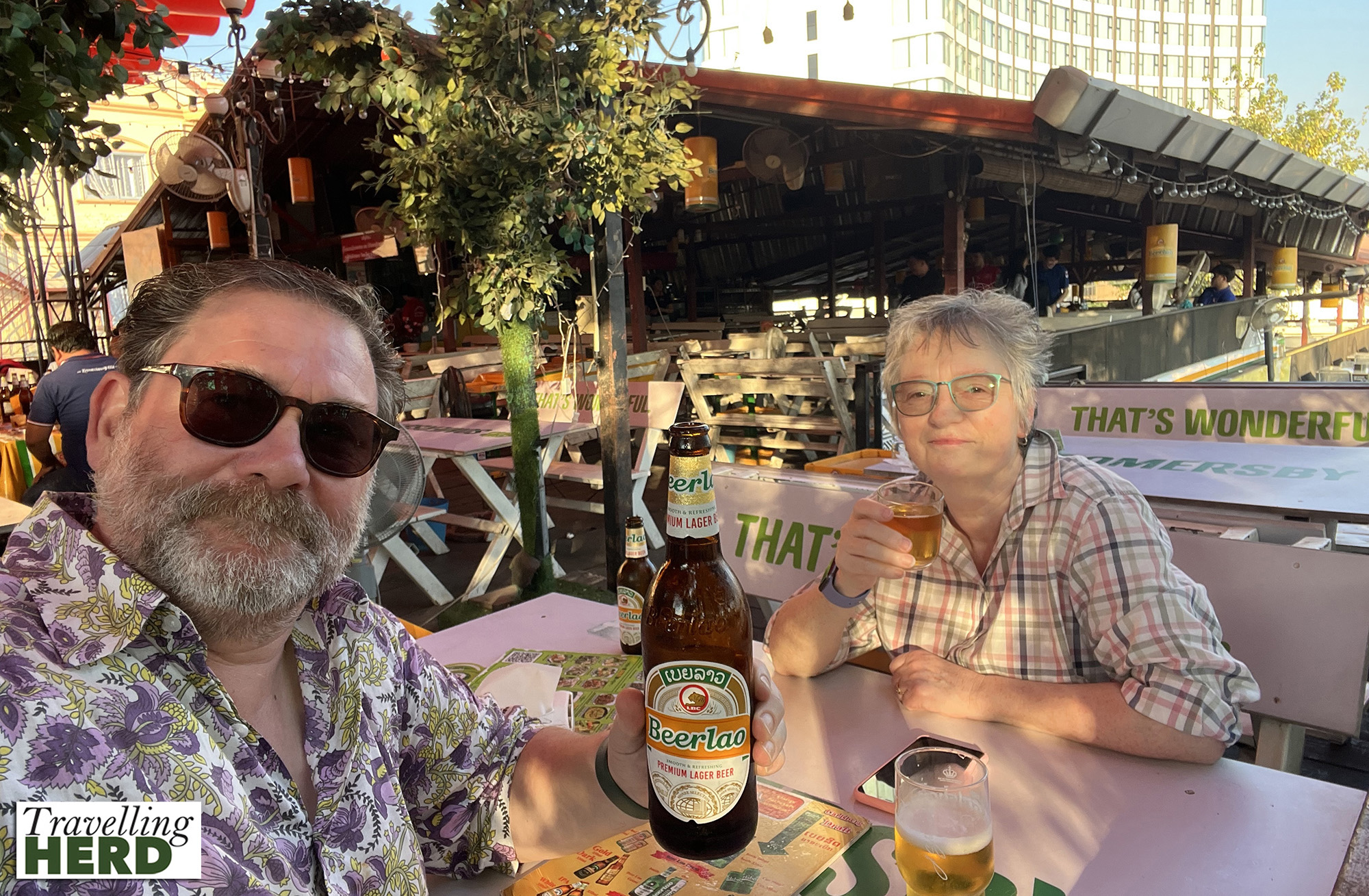
We then walked further into the centre and found Robert’s 51st Hard Rock Café arriving just in time to take advantage of party hour more commonly referred to as happy hour. As it was Valentine’s Day and we thought many places would be busy or fully booked we took the easy way out and decided we would eat here [see Dish of the day].

The following morning we planned a route taking in several temples on our way to find breakfast. The first of these was the Wat Inpeng temple on Setthathirath Road. Within the temple compound there is a library and a small chapel as well as the sim – the main building or ordination hall in a Buddhist temple, which is often the most richly decorated building. Usually eight boundary stones around the sim mark out the holiest area.
The sim at Wat Inpeng is beautifully carved and decorated in green and gold.

There are also richly decorated shrines and . . .
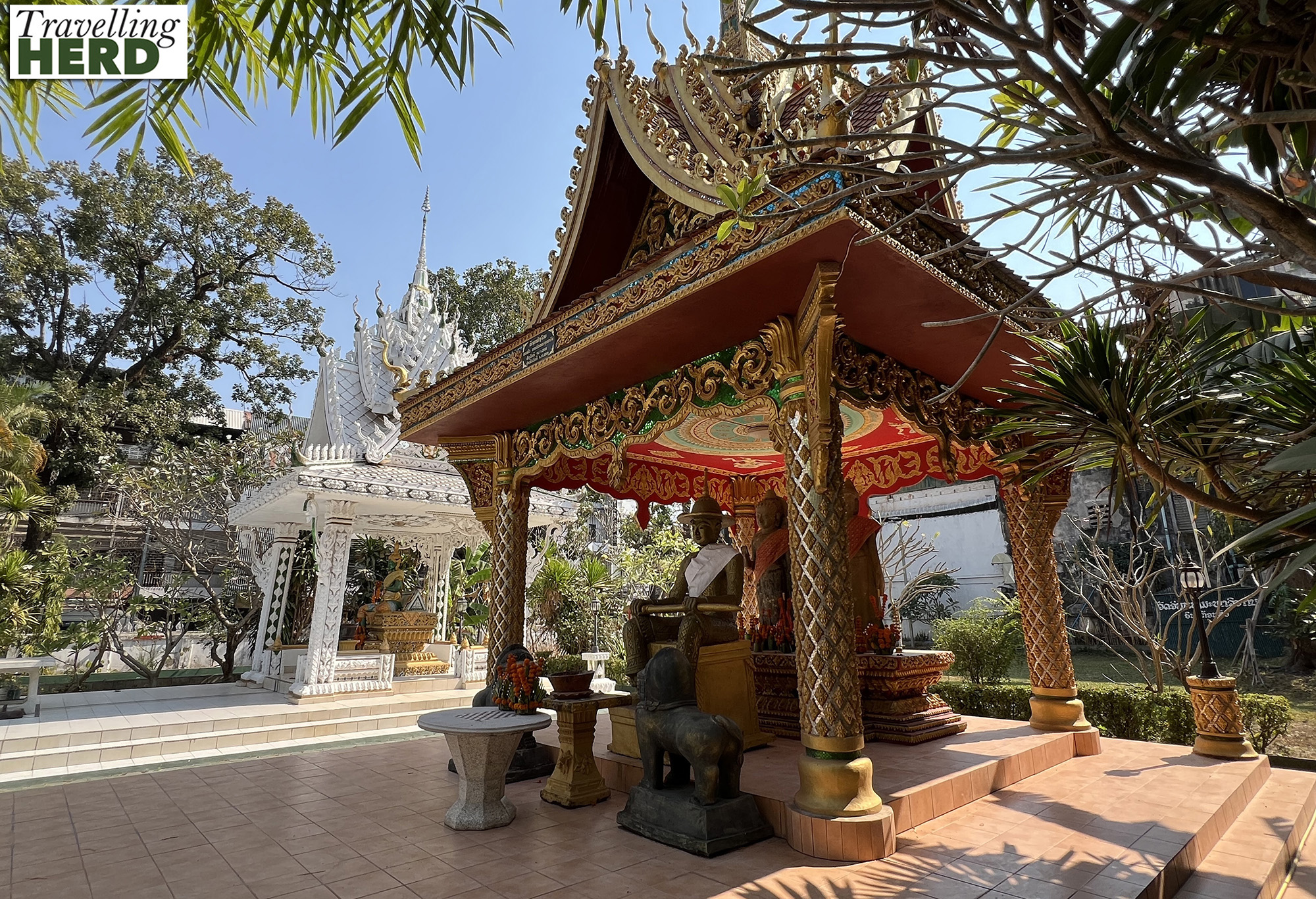
. . . a peaceful garden with statues surrounds the temple buildings.
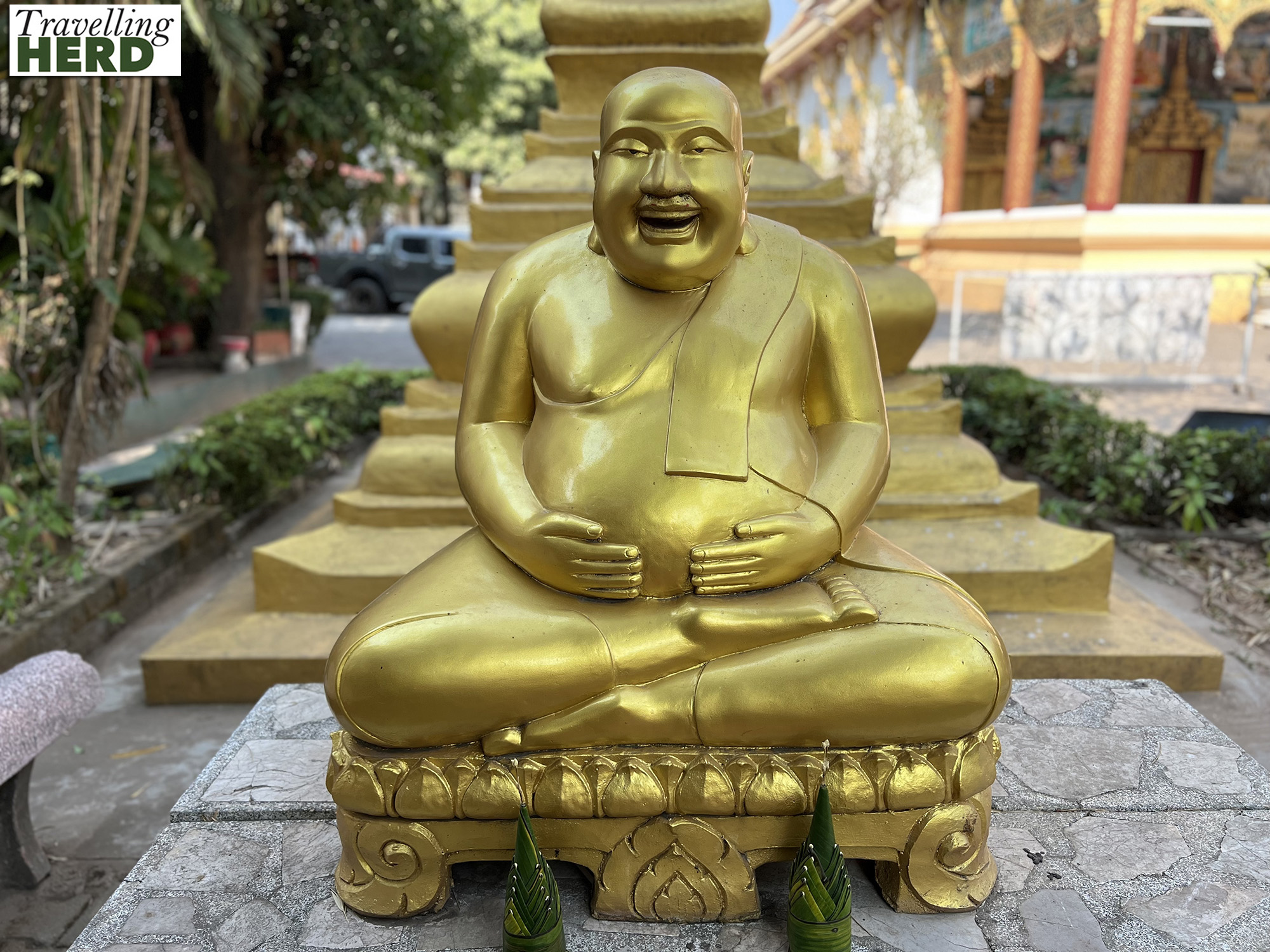
We continued along Setthathirath Road. Matilda is always pleased to see a sign implying her favourite beer will be available and many places were still decorated from Valentine’s Day.
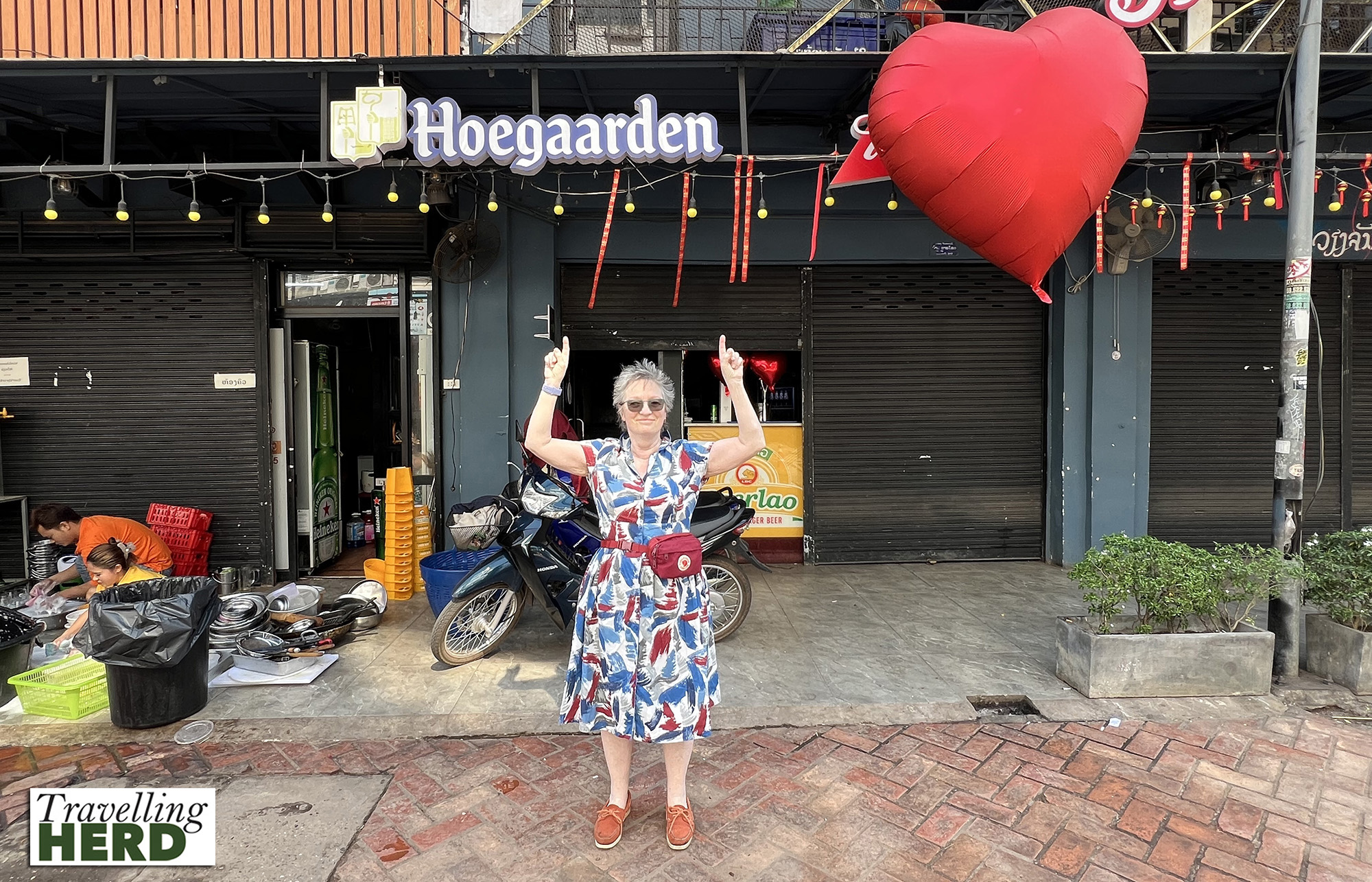
The next temple on our route was Wat Ong Teu Mahawihan or the Temple of the Heavy Buddha.
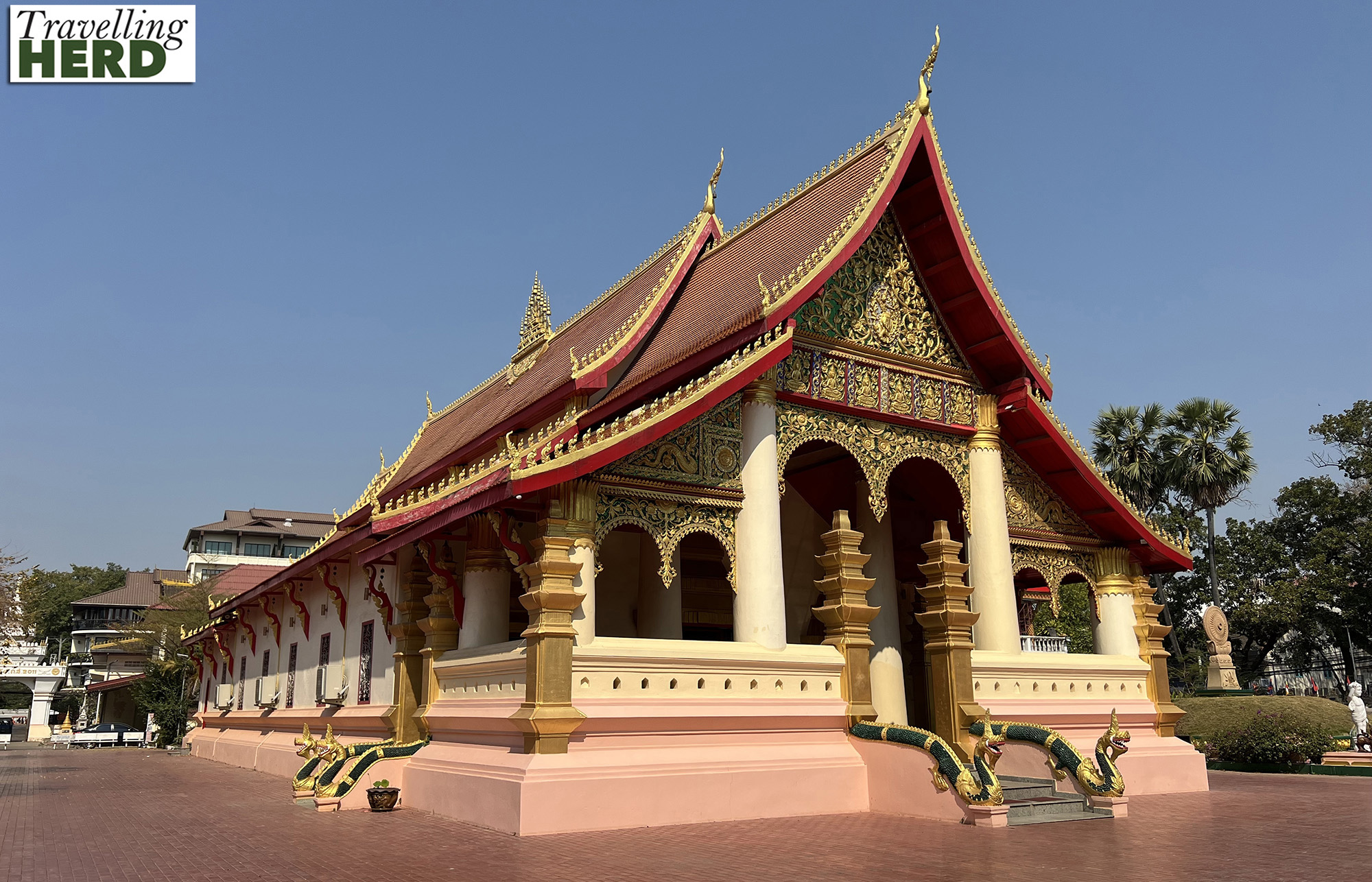
We weren’t sure that that was a sufficiently exclusive description but the temple derives its name from the large bronze statue of Buddha which is housed here, said to be the largest in the city.
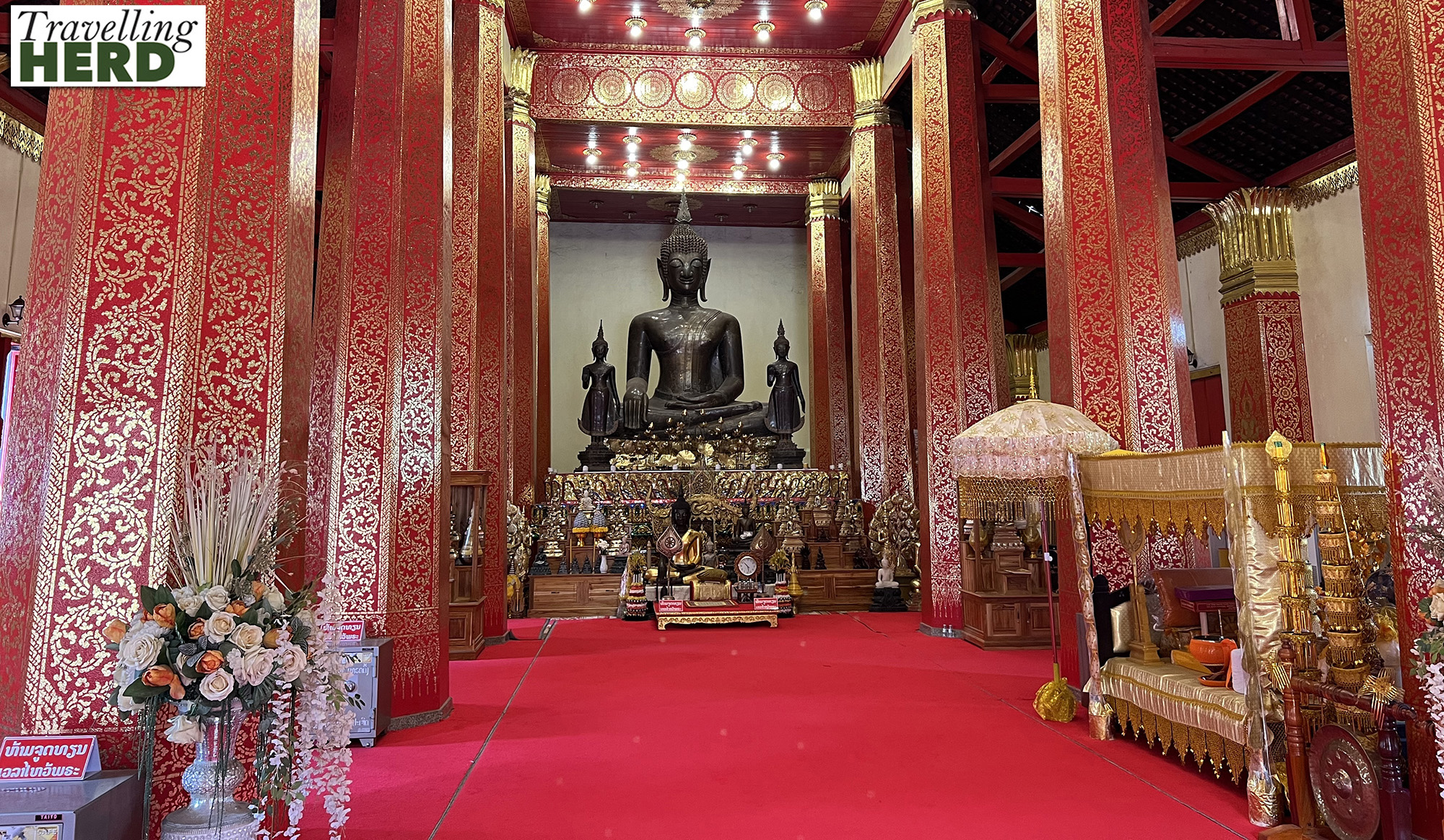
A little further along the street striking, carved warrior statues guard the entrance to Wat Mixay where the peace was only broken by a territorial dispute between felines.
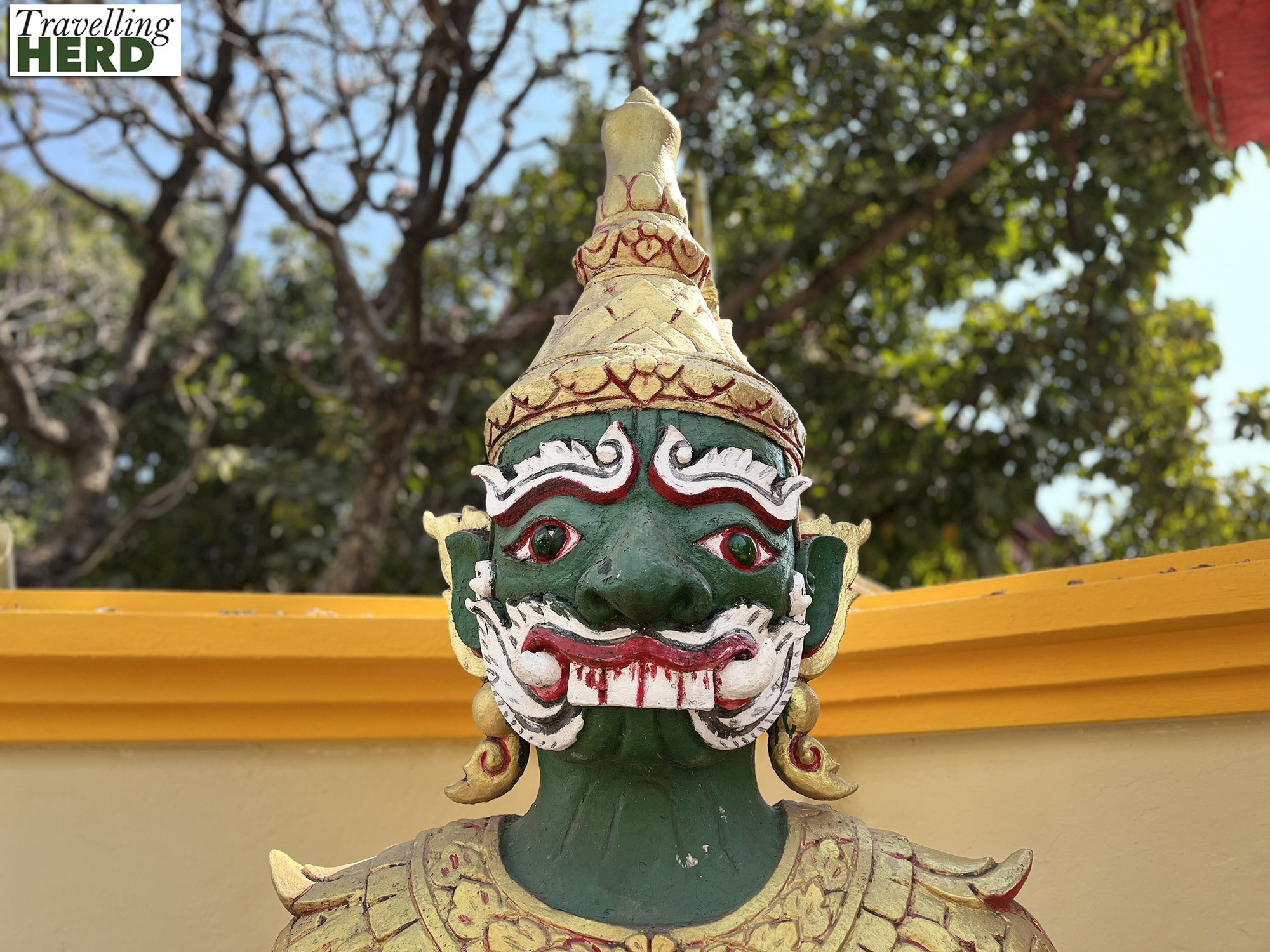
Robert had not booked breakfast at our hotel and when they offered it to us at check-in we were told that it would cost $16 per person which Robert subsequently calculated would be the equivalent of a 20% increase on the overall cost of a nights’ stay.
We decided we could easily find breakfast in Vientiane for less. Matilda had read about the JoMa Bakery Café which operates on several sites in the city. We were ready to stop when we spotted one of them further along Setthathirath Road.
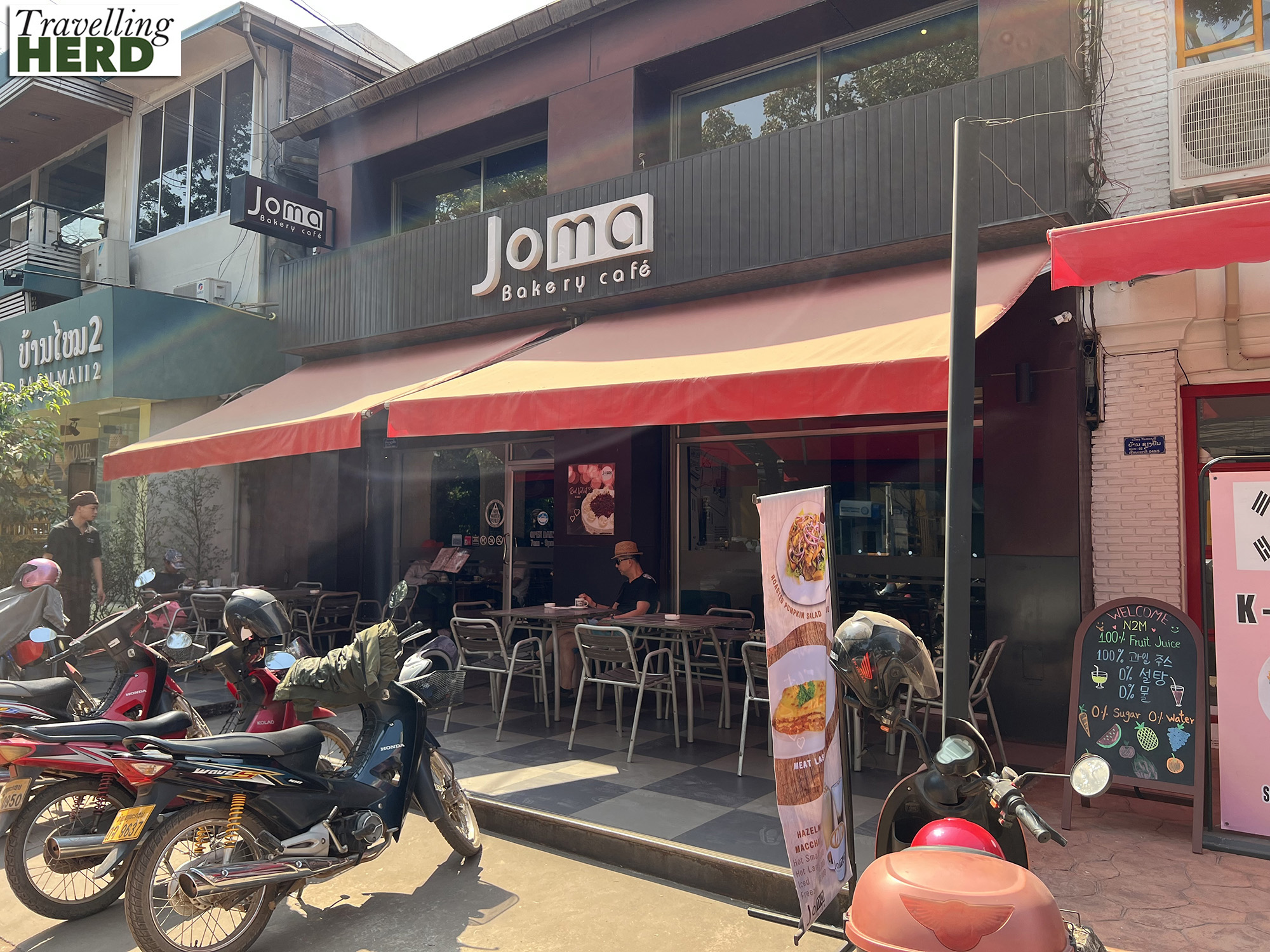
Refreshed by coffee and cream cheese bagels, which cost just £8.00, we continued on our way to Wat Si Saket, and passed the city fountain which, despite containing water, was not flowing [see Selfie of the day].
Many temples were destroyed between 1827-1828, during the invasion by the Siamese who razed most of Vientiane. The majority of the residents were forced into exile across the Mekong River.
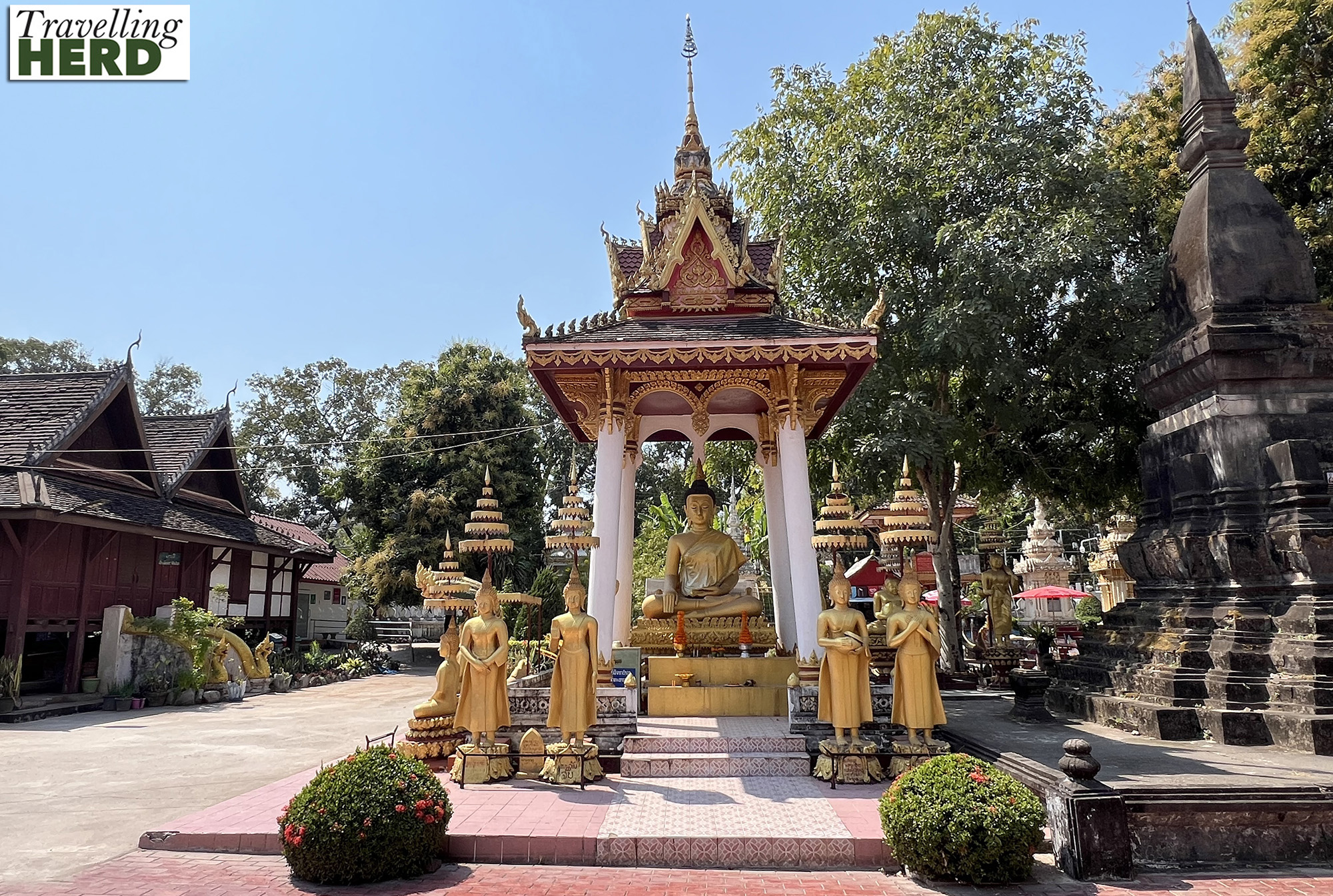
A cloistered gallery runs along the four sides of the area around the sim, at Wat Si Saket designed to separate this sanctuary from the non-religious world. It still houses 120 original identical brick and stucco sculptures of the Buddha seated on a lotus blossom as well as the small statues in the six layers of wall niches. During the restoration in the 1920s by Prince Phetsarath, a second lower platform was added to display the many Buddha statues recovered from the temples destroyed by the Siamese. In all there are over 2,000 statues in the cloisters.
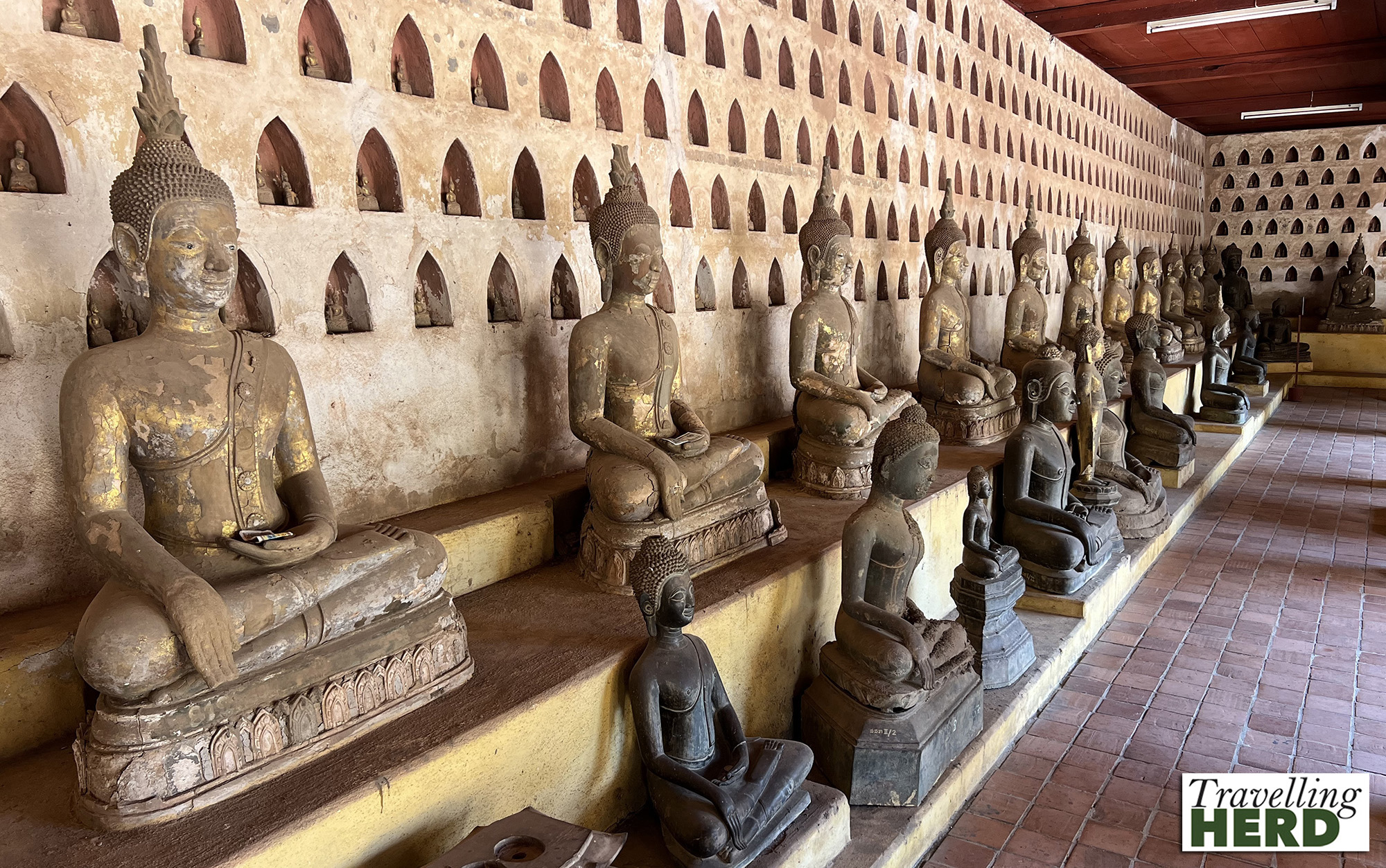
The sim at Wat Si Saket has a five tiered roof reminiscent of Thai temples and this may have helped to preserve the buildings as they were used as the headquarters of the Siamese army which sacked Vientiane. Wat Si Saket was perhaps the only temple to survive in its original shape and it continued to be used as a monastery despite the depopulation of the city. The sim is said to contain with the oldest murals in Vientiane.
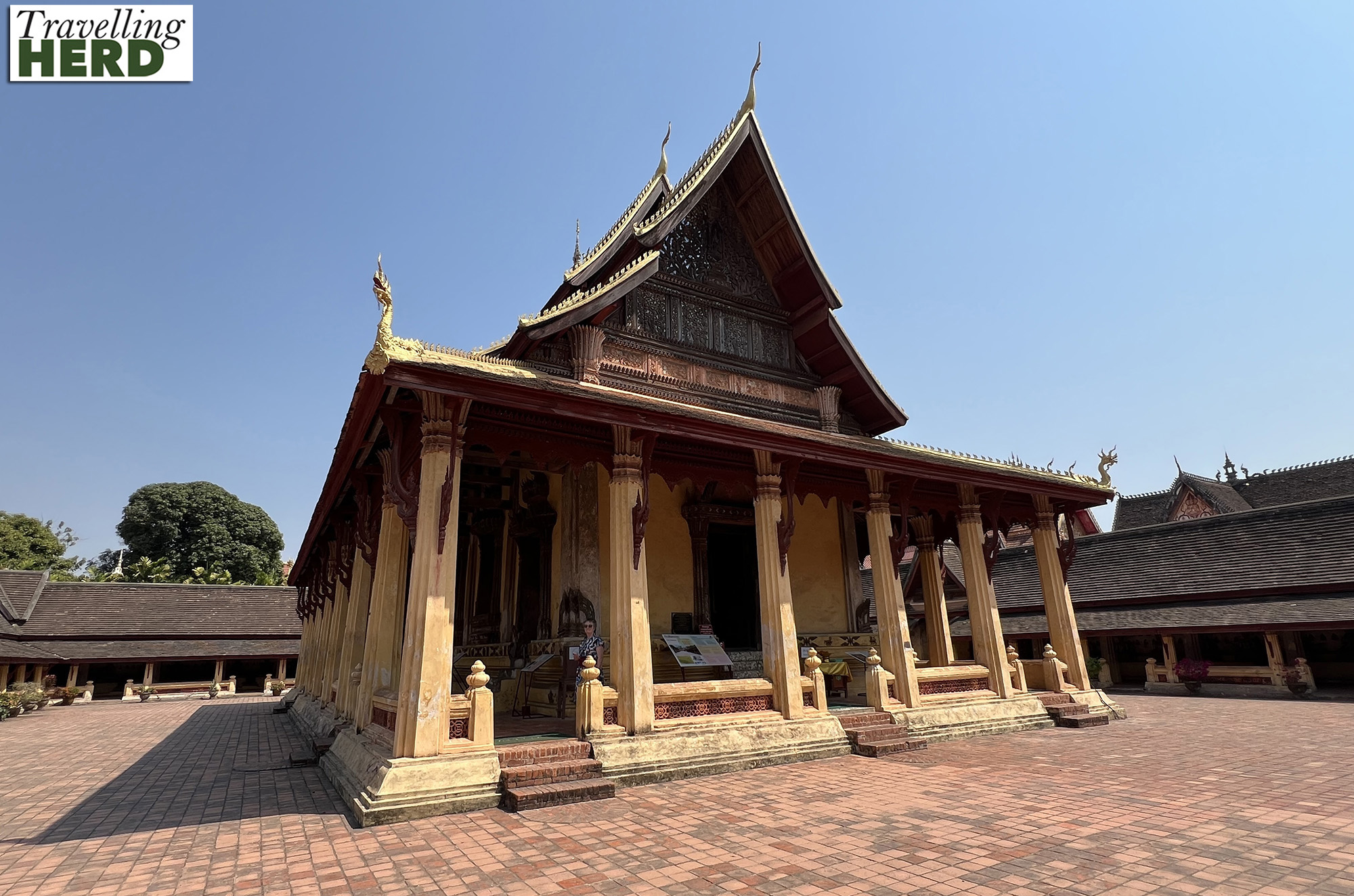
Continuing our walk we came to the Sacré-Cœur [Sacred Heart] Cathedral, also known simply as Vientiane Cathedral. It was built in 1928 during the French colonial period but when we passed the windows had been removed and it was obviously undergoing some extensive restoration so we could not go inside.
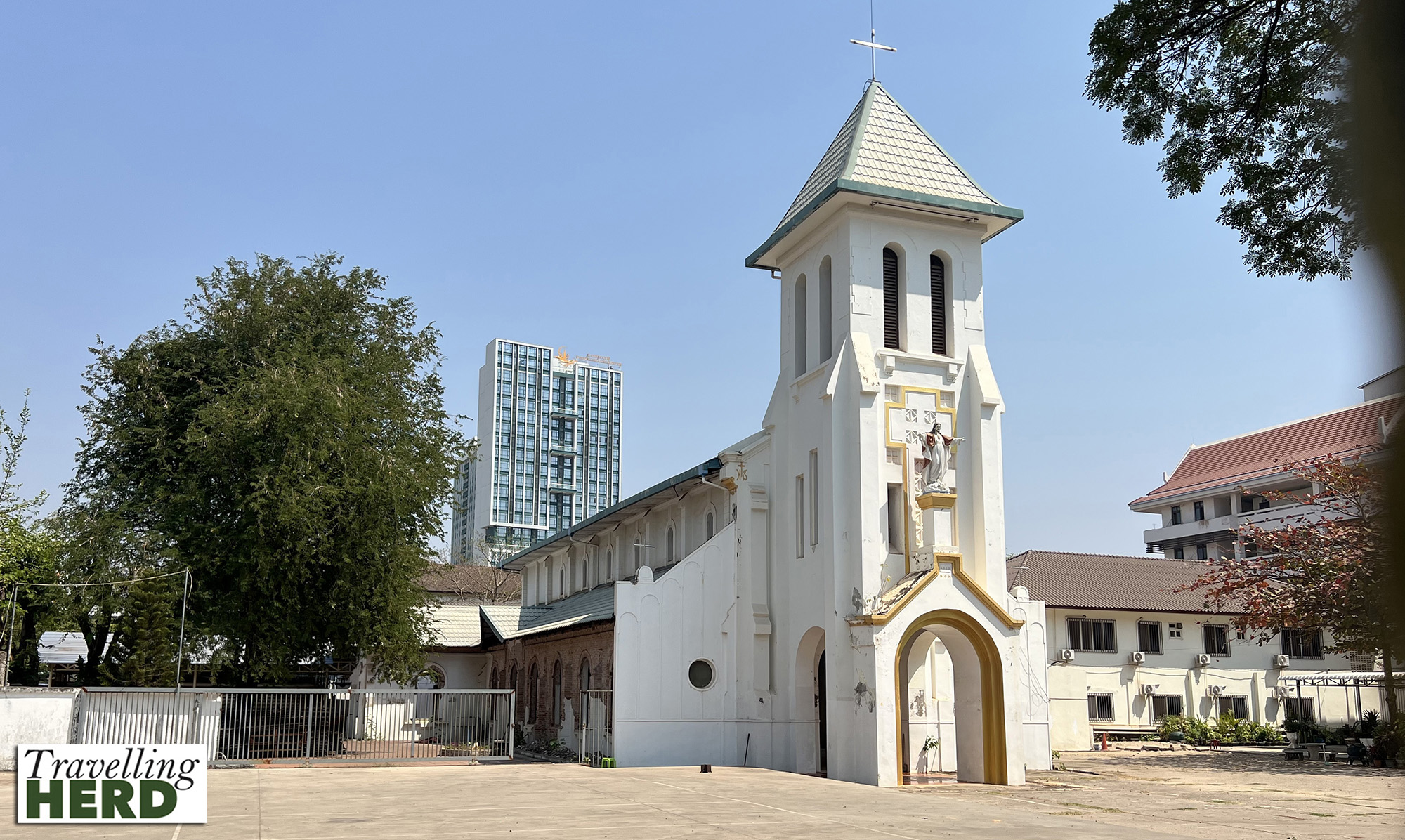
The Hor Lak Muang or the City Pillar Shrine was completed in 2012 and although comparatively modest in size it is said to hold the spirit of the city. It stands on a site where more than 473 stone fragments were discovered that are believed to have formed part of an ancient pillar dating from the 4th or 5th century BCE.
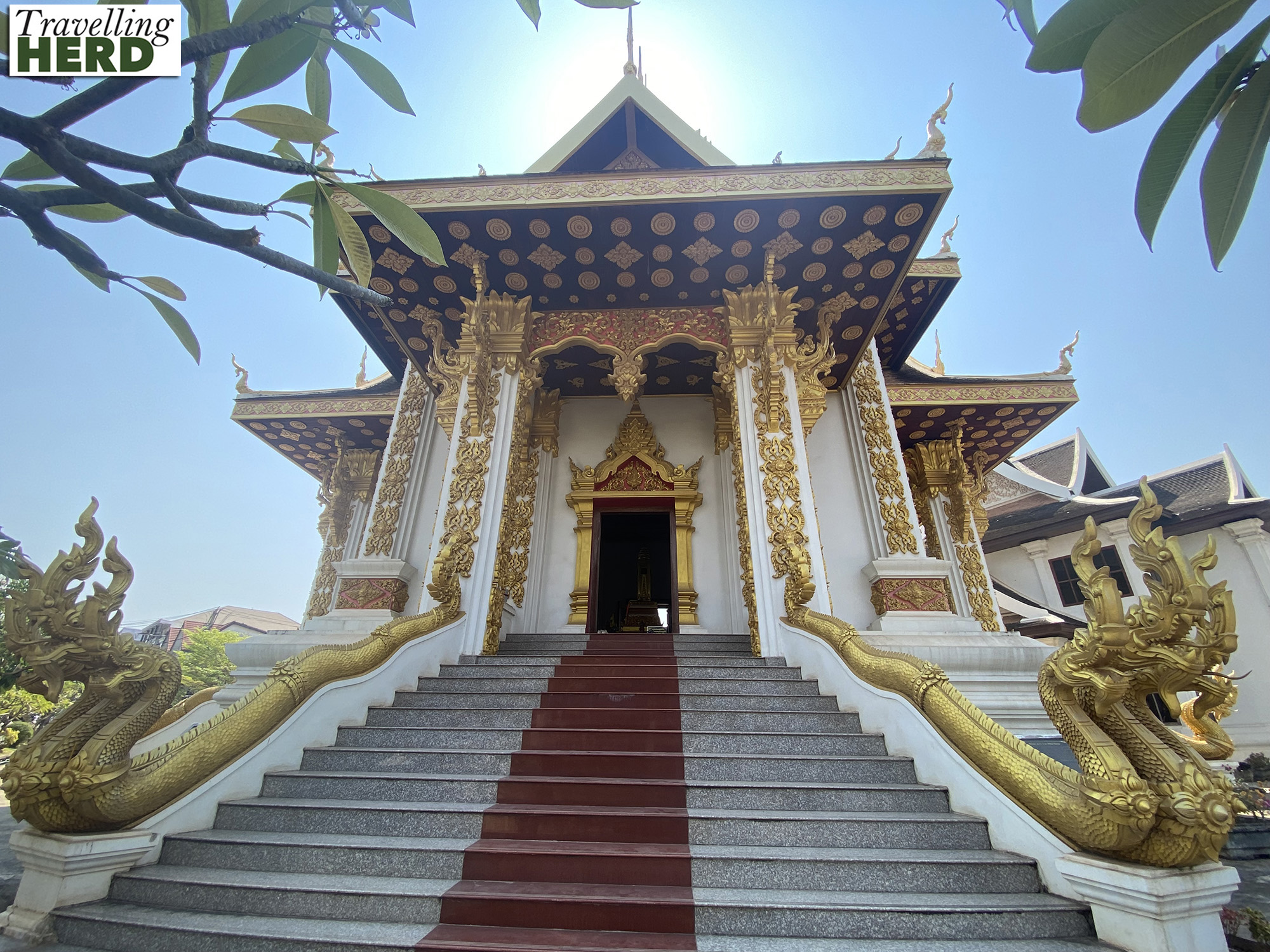
Nearby, That Dam, also known as the Black Stupa, was once covered in pure gold. Now standing on a quiet roundabout near the Talat Sao or Morning Market, the Siamese plundered the gold leaving the basic 16th-century brick structure remaining.
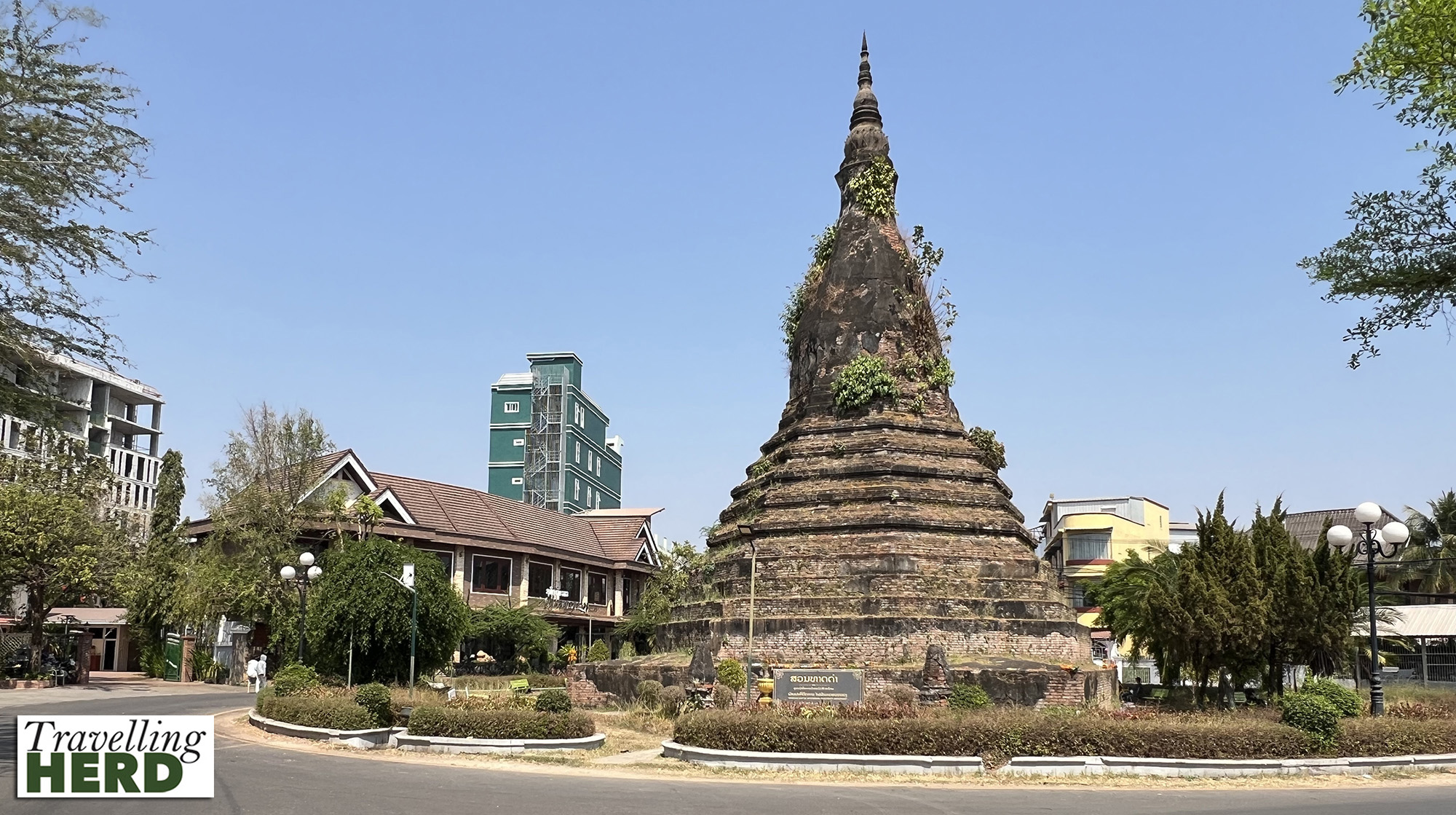
Facing That Dam we found Hichillico Café in the ruins of an old, colonial-style building and stopped to rehydrate. It reminded us of the ruin bars in Budapest.
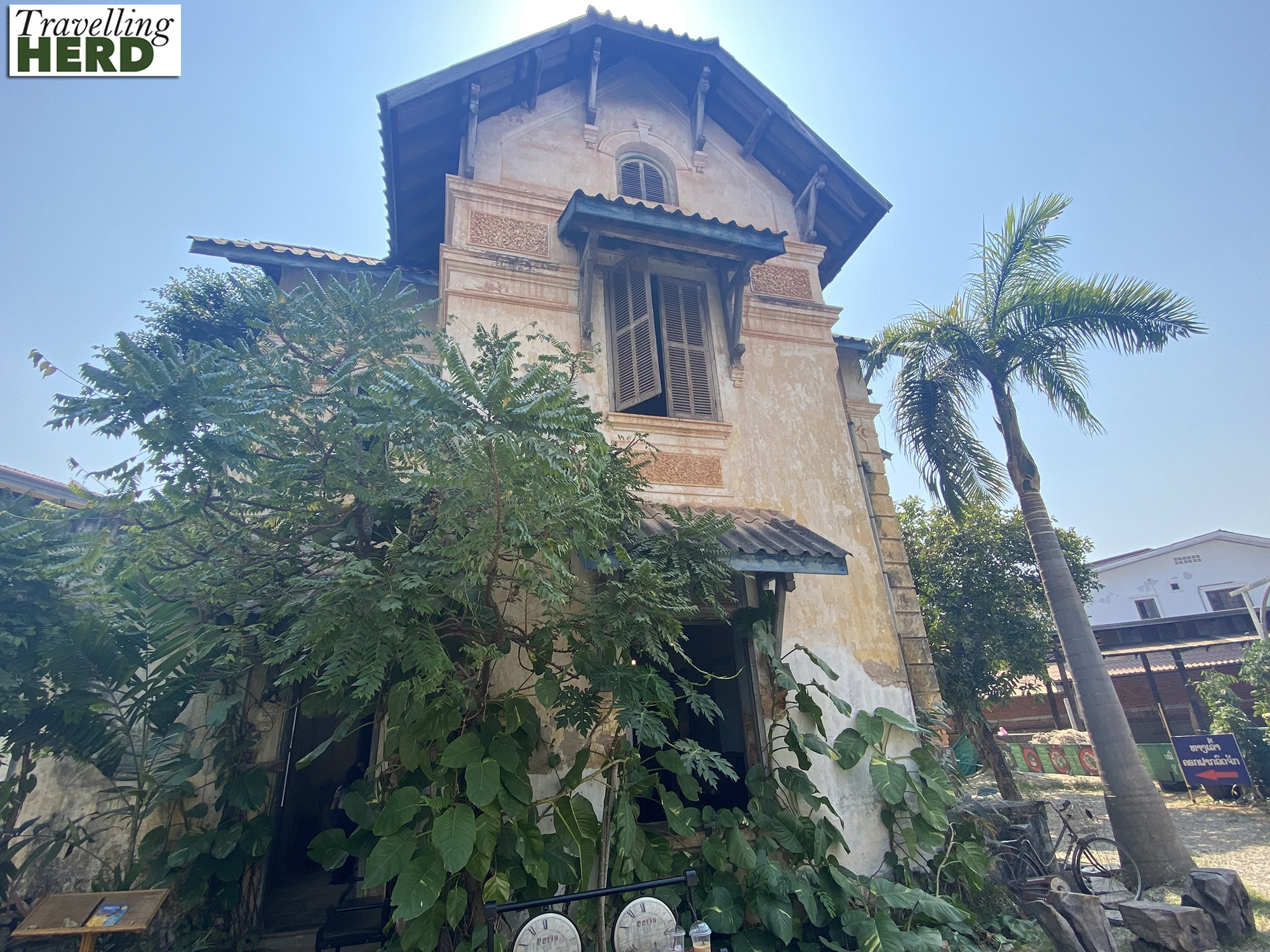
From here it was a short walk to the air conditioned Talat Sao or Morning Market. The air-conditioning was most welcome but we did not feel the need to purchase anything more to add to our luggage.
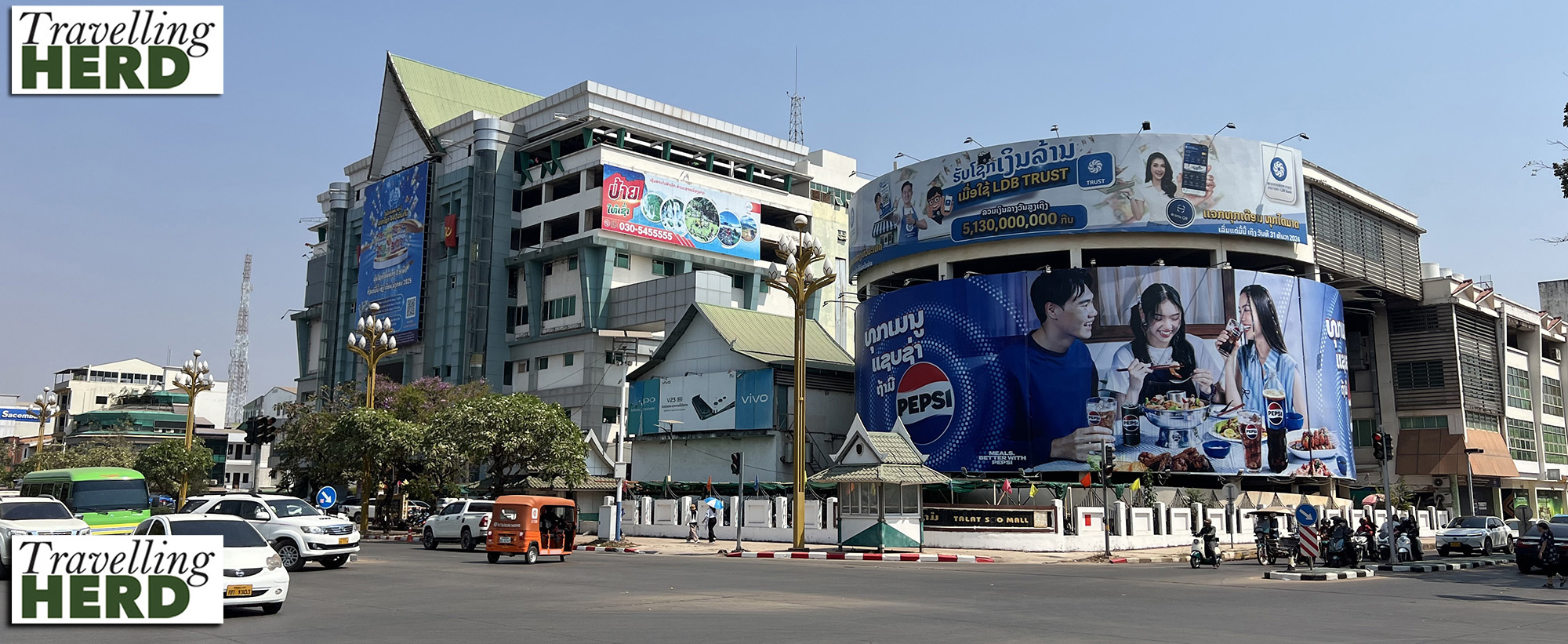
The Patuxai [literally Victory Gate] stands in Patuxai Park.
This is a massive concrete arch decorated with Buddhist symbols and Hindu deities. For 5,000 kip, [less for local Lao people] foreigners can climb a spiral stairway to the tower’s observation deck for views of the city. We both felt too hot to start the climb.
Ironically, given its similarity to the L’Arc de Triomphe complete with a French-style wide boulevard leading to the President’s Palace, the monument was built to commemorate those who fought in the struggle for independence from France.
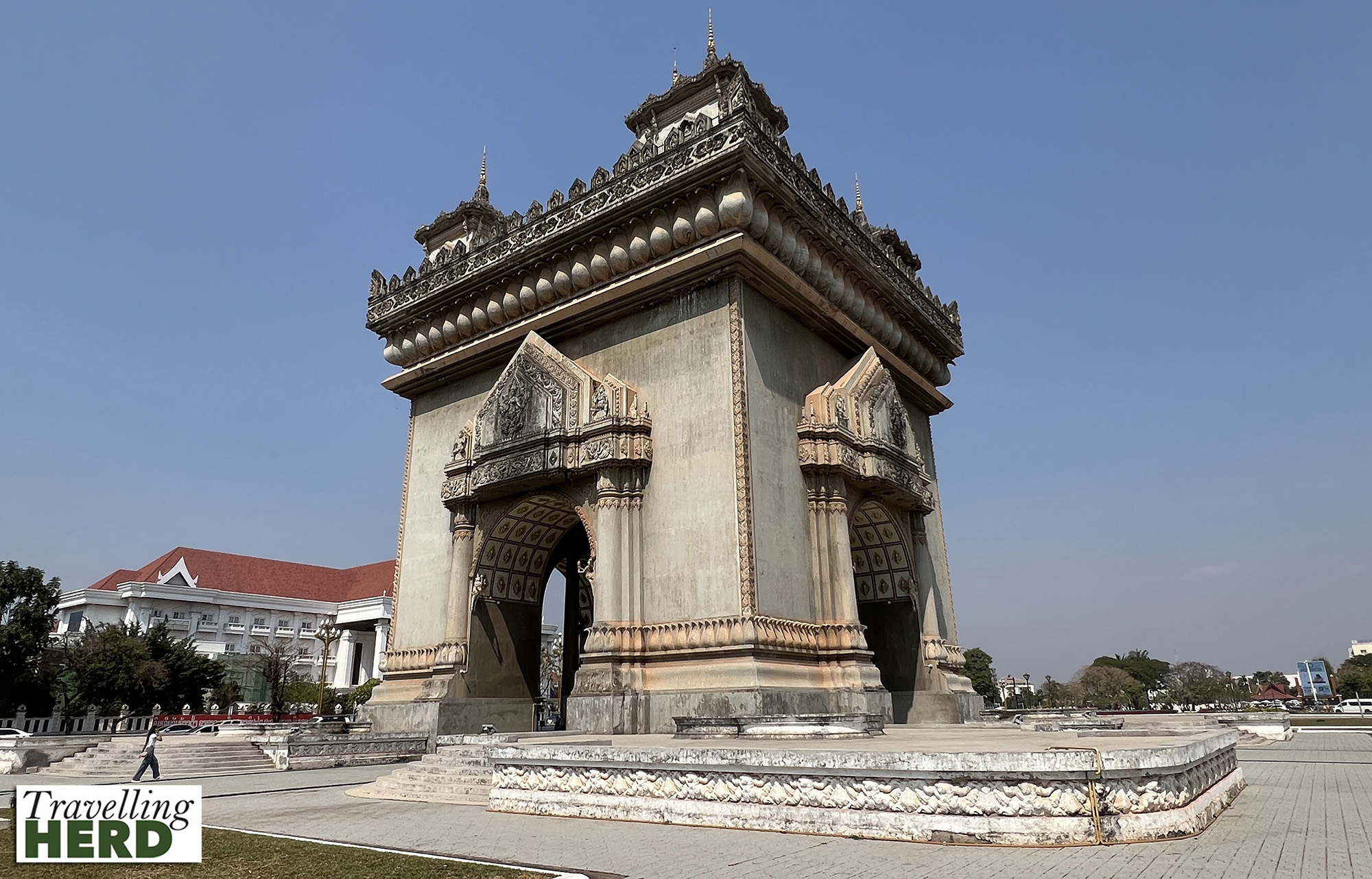
The Patuxai was built between 1957 and 1968 and is apparently also sometimes referred to as the “vertical runway” as it was constructed using American funds and cement actually intended to build a new airport. Instead, the Royal Laotian Government diverted these resources to build the monument.
From Patuxai Park we decided to get transport back to our hotel for a dip in the pool. An electric tuk tuk was conveniently close by and after confirming our destination and a price we set off [see Video of the day].
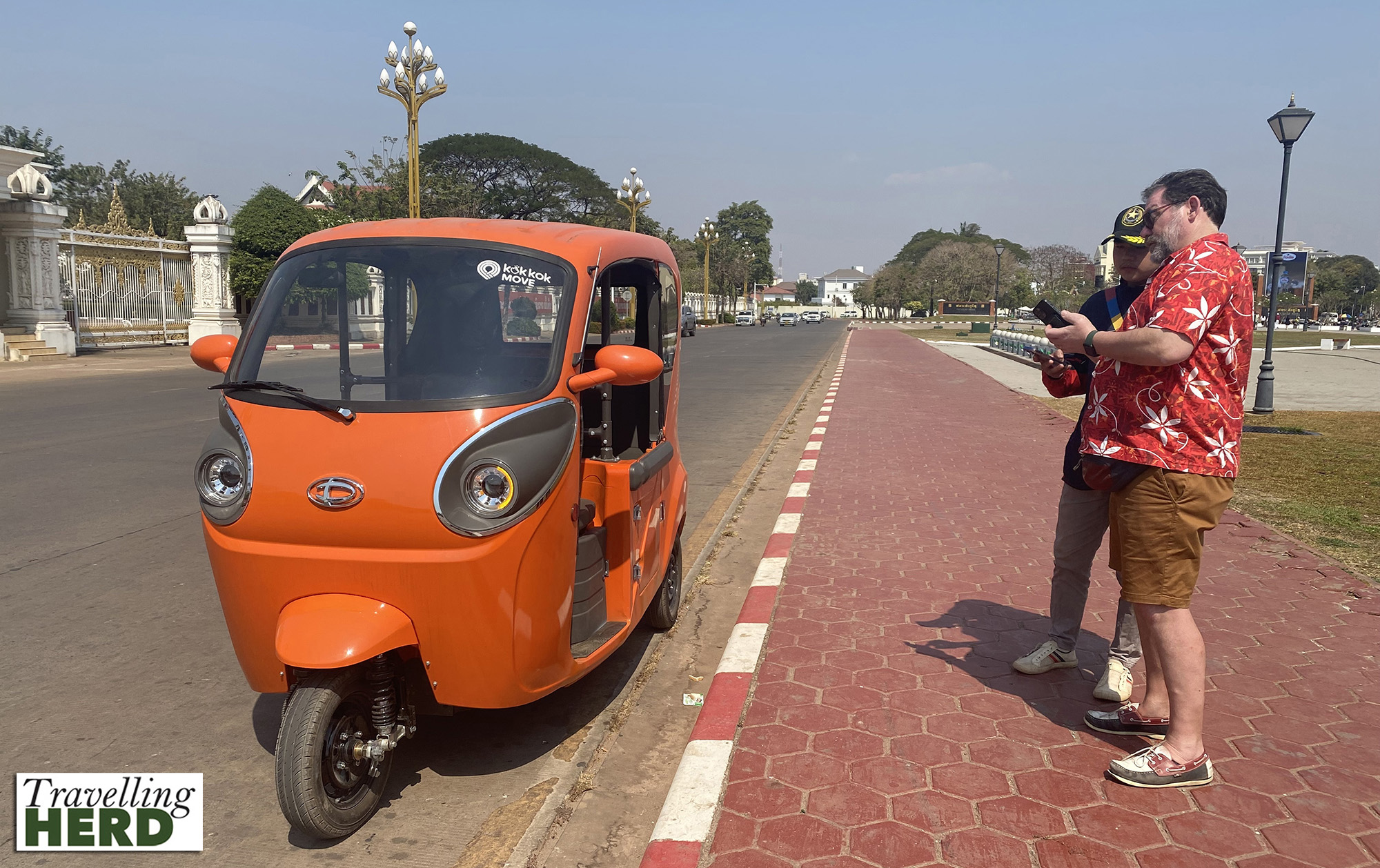
Back at the hotel a calorie free cake had been made using towels and ribbon decorated with rose petals. Matilda suspected that the ribbon and roses were left over from the Valentine’s party by the pool but it was a lovely thought.
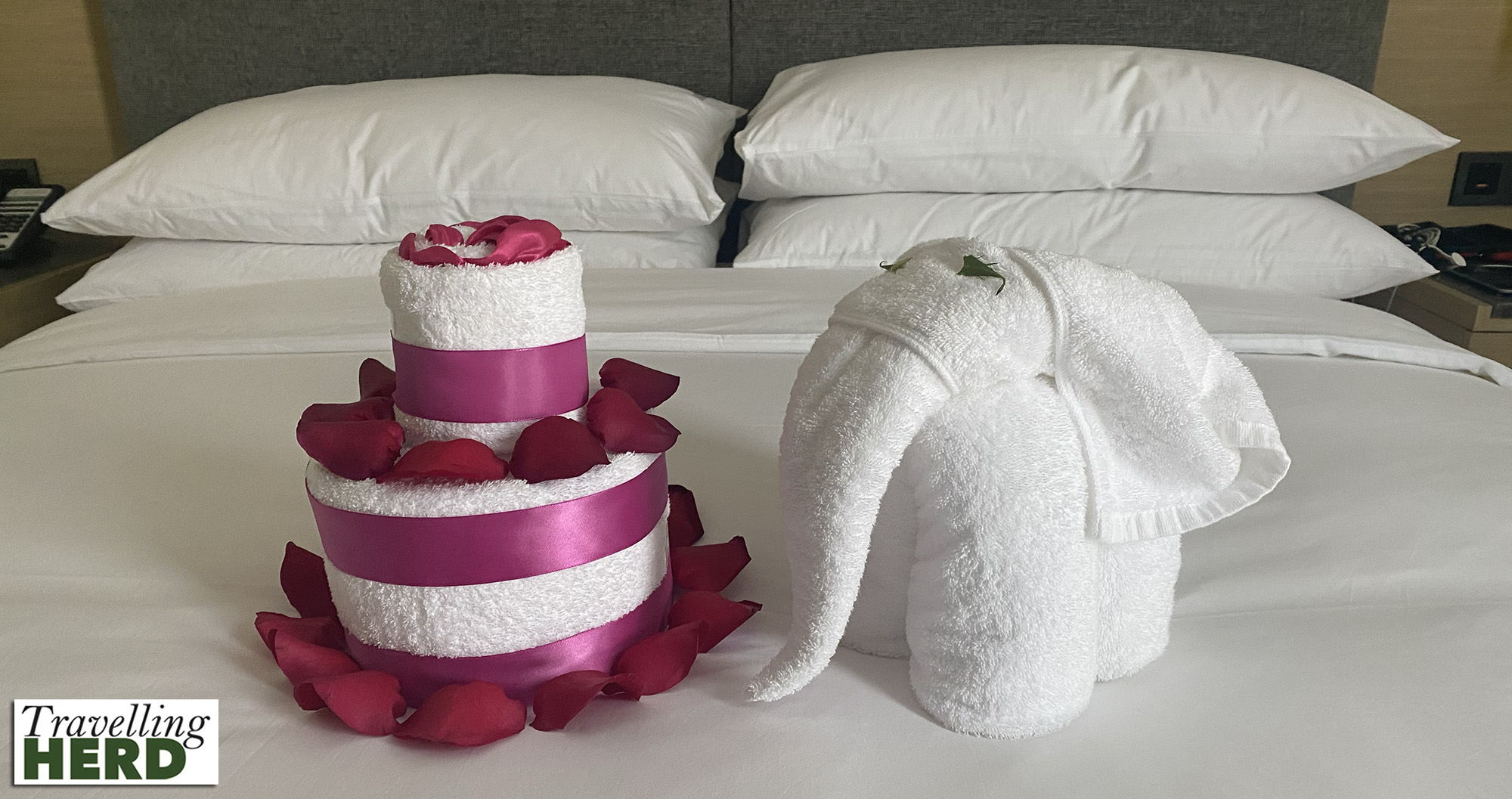
A dip in the pool proved very refreshing, helping to lower Matilda’s core body temperature but Robert decided it was too cold and did not even get his shoulders wet.
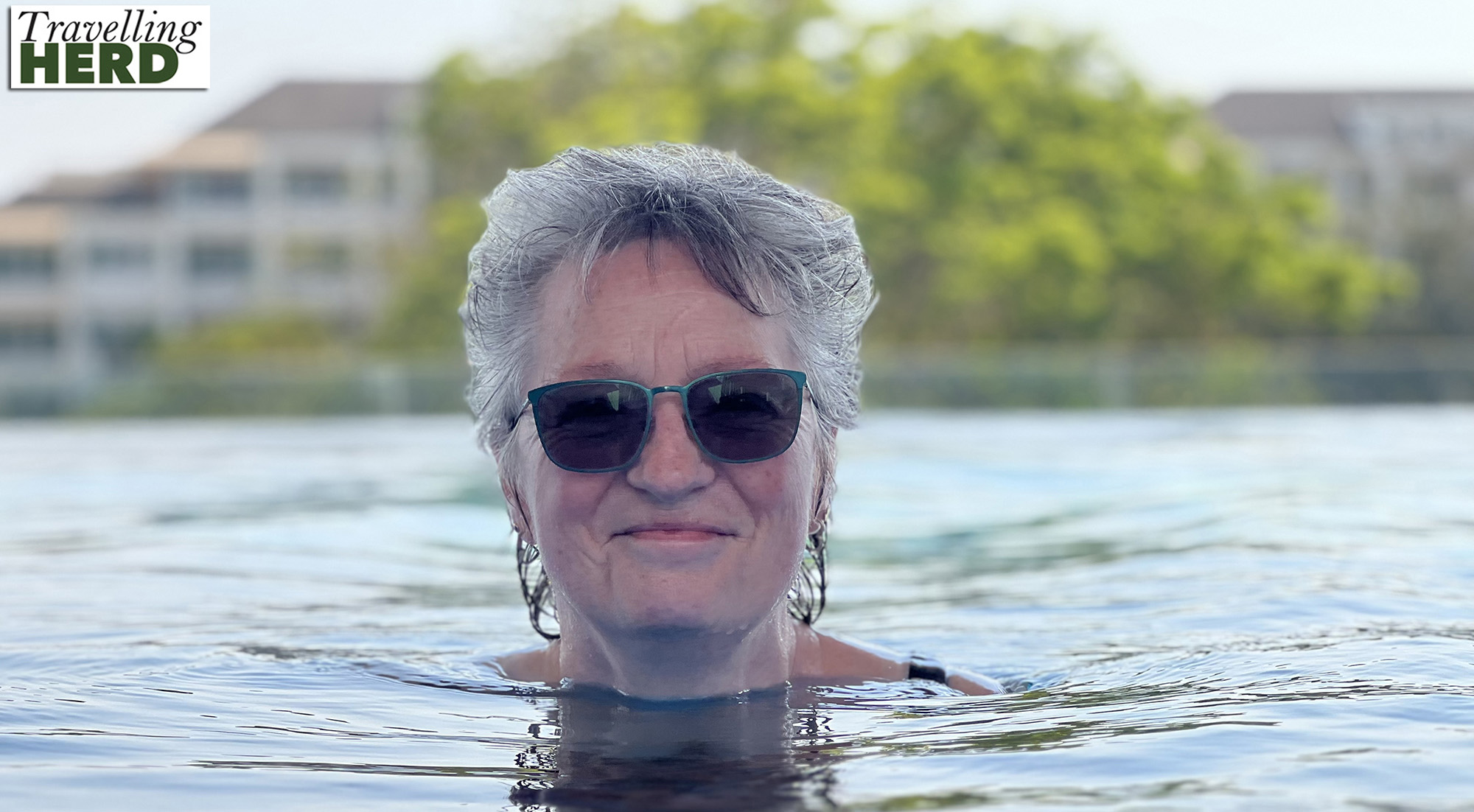
Heading out for celebratory drink later, Robert remembered that he had forgotten to register his visit to the Hard Rock Café the day before and so we agreed to return to rectify this. There is no happy hour on a Saturday but Matilda let slip it was her birthday and the assistant manager gave us both a free drink and the staff serenaded her [see below] and Mr Kim, the assistant manager provided a very decorative cake.
In the UK we use Über but in Asia the dominant app is Grab, and we used it extensively in Asia last year. The advantage of Grab is that the app sets the price. You never know, as a foreigner abroad, whether the taxi prices you are quoted when you hail a cab are the going rate or a vastly inflated tourist rate. With Grab you know the price in advance but then pay the driver direct with cash at the end of the ride.
We found Grab is not used at all in Laos so we needed an alternative. We would like to thank Sackda also known as Ben, the charming and helpful barman at the Hard Rock Café for telling us about the inDrive app. Many of these taxi apps use texts for confirmation. With inDrive there is the option to select WhatsApp for confirmation.
Most of the electric tuk tuks are run through an app called kokkok MOVE, but in order register to use the app you need to have a working text number so that the app can approve you. While on tour we use data eSims from Nomad so can easily and cheaply use local data/internet but we are never allocated a local telephone number. For messaging we use iMessage or WhatsApp which are data based not text based, so if you want to use kokkok MOVE we would have needed to register in the UK, which we didn’t, as Robert assumed Grab would work. The interesting distinction between inDrive and Grab is that with inDrive you say how much you are prepared to pay and then a driver accepts it or not. If no driver accepts it you can just up your offer until one of the drivers accepts [you also get a recommended price suggested].
When we returned to our hotel room we found the slimming free cake had been supplemented by a highly calorific one.
Robert maintained that he had carefully orchestrated the birthday surprises but Matilda suspects she has the kind and thoughtful people of Lao to thank.
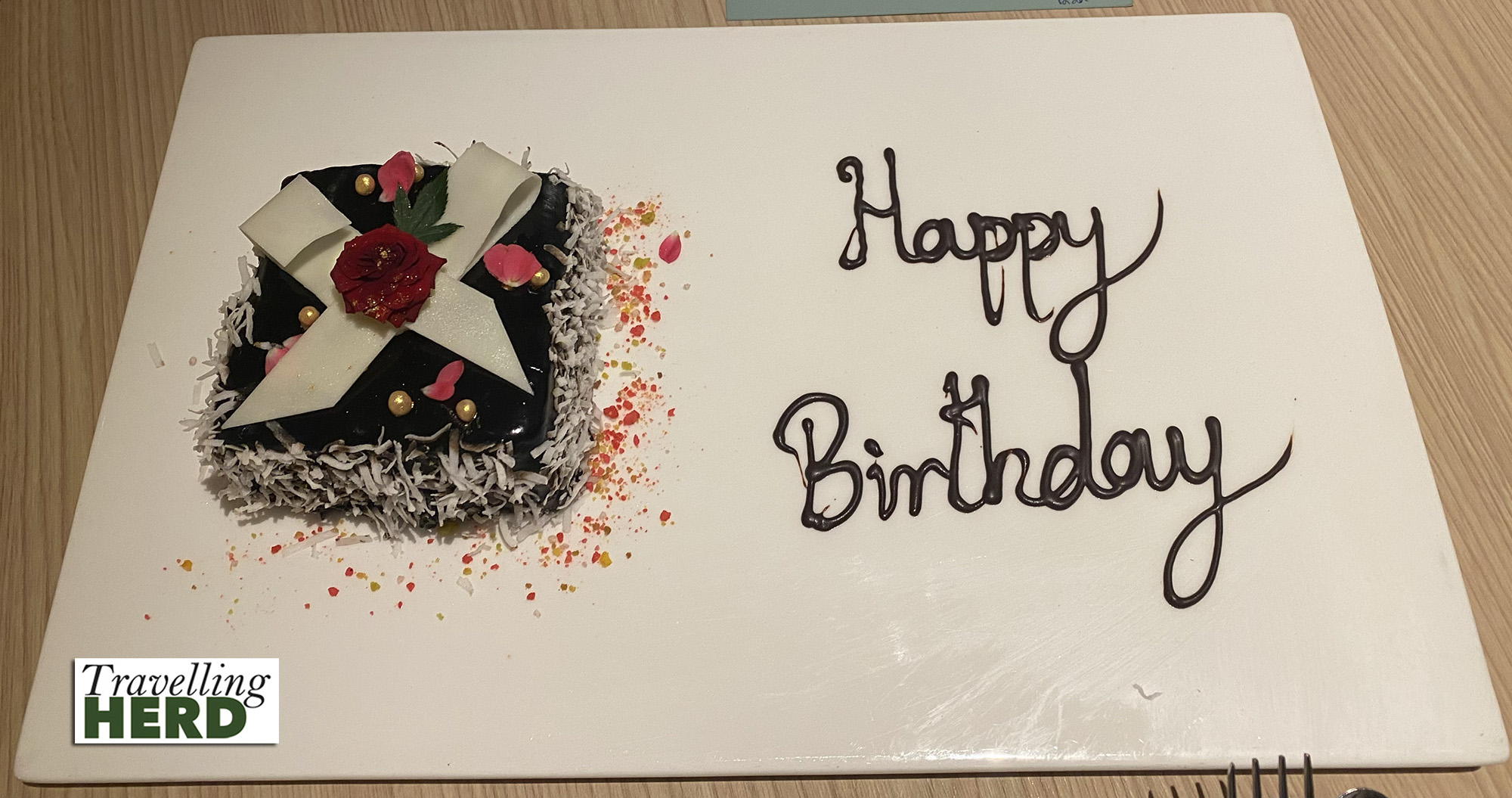
Video of the day:
Selfie of the day:
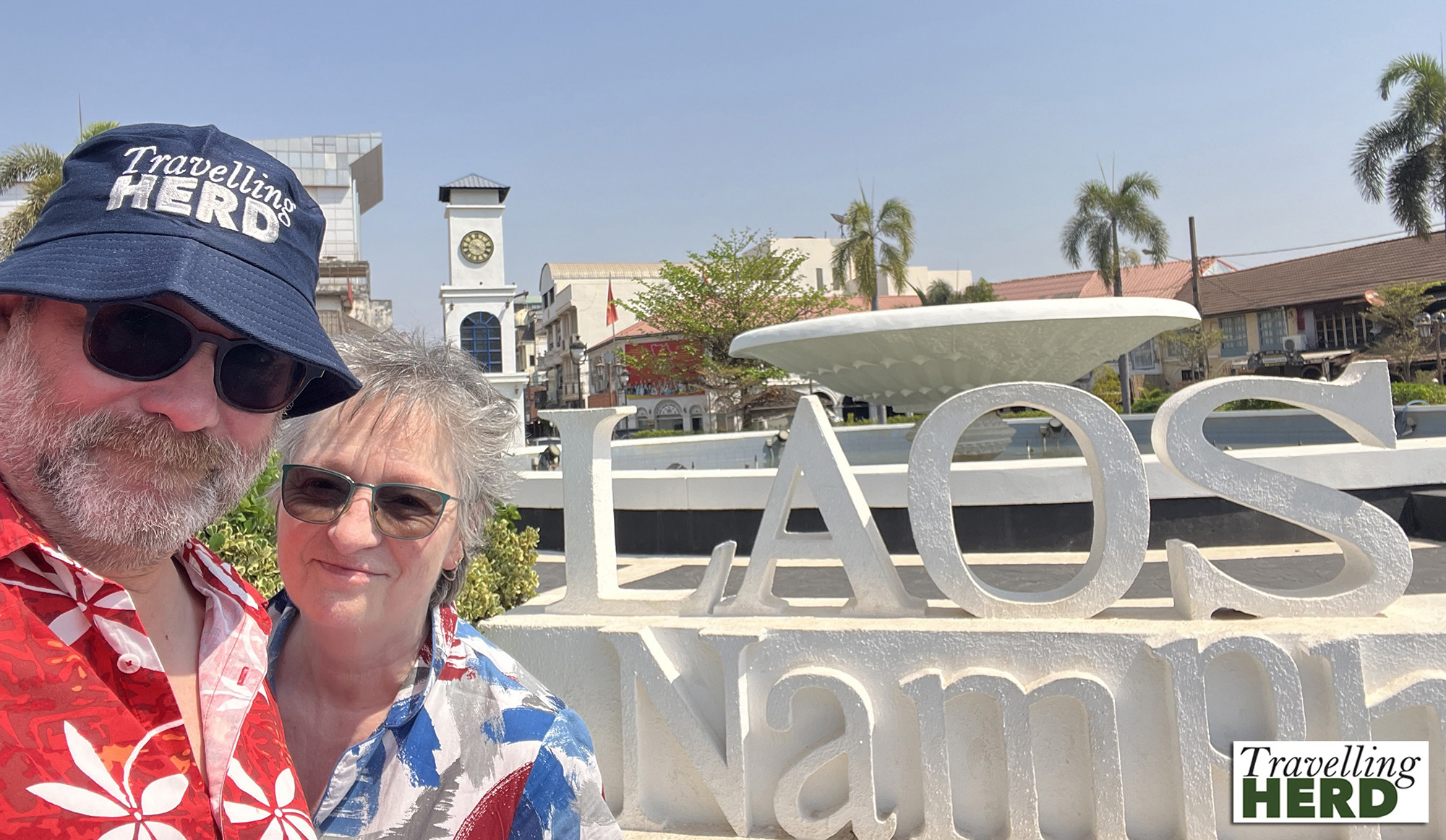
Dish of the day:
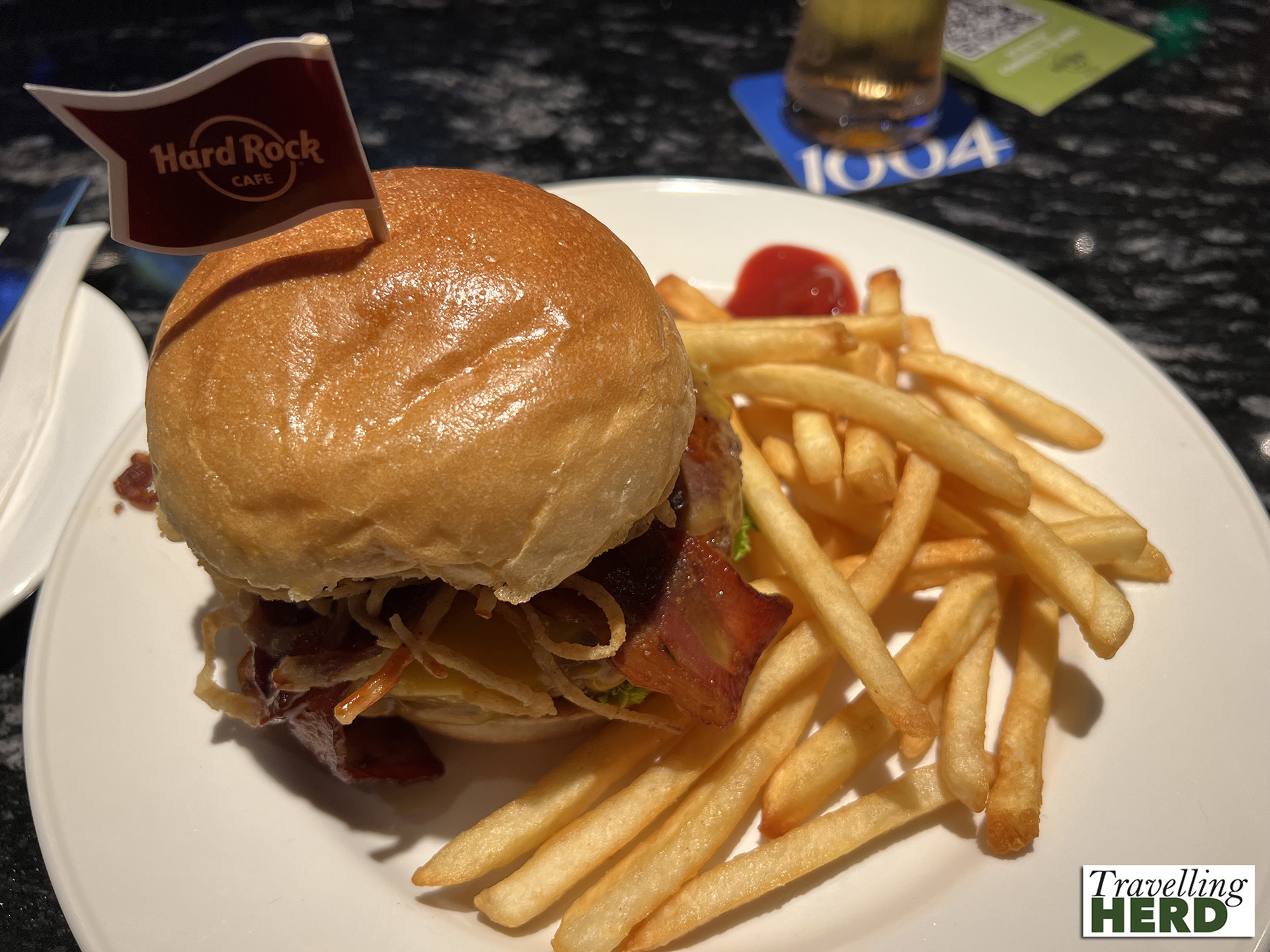
Route Map:
